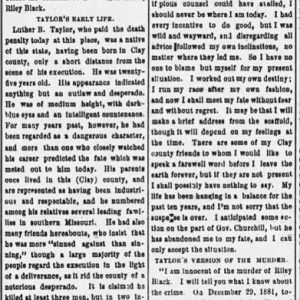calsfoundation@cals.org
Luther B. Taylor (Execution of)
Luther B. Taylor was hanged at Corning (Clay County) on April 21, 1882, for a murder he claimed was committed by another man.
Luther B. Taylor was born in Clay County around 1858, the son of “industrious and respectable” parents. He was of medium height and had “dark blue eyes and an intelligent countenance” but, by the early 1880s, “had been regarded as a dangerous character” who had been involved in Reconstruction-era violence in southern Missouri, where “he was credited with having killed as many men as the most ferocious partisan.”
On December 29, 1881, Taylor left the Iron Mountain Railroad depot at Nellville (Clay County) with Riley Black and William Mullholland. As they were walking home, Taylor reportedly pulled out a bottle of liquor and offered his companions a drink, but “he and Black got into a dispute, which ended in Taylor springing on Black and cutting his throat from ear to ear.”
Taylor and Mulholland were arrested for Black’s murder, and a coroner’s jury charged Mulholland with the slaying, but he turned state’s evidence and, at trial, blamed Taylor for the killing, with the latter saying, “I could not escape from the toils he so cunningly wove around me.” Taylor, who was a suspect in three other killings, was condemned to death and sentenced to hang on April 21, 1882, while Mulholland received a three-year prison sentence.
Many people believed Taylor to be innocent of Black’s murder, and Mulholland reportedly confessed to the killing several times, “yet refuses to make oath to that effect” for fear of being executed himself. Governor Thomas Churchill declined to commute Taylor’s sentence.
On the night before his execution, Taylor was transported to Corning from the state penitentiary in Little Rock (Pulaski County), where he had been taken to make sure he could not escape. He was then lodged in the Clay County Courthouse. An Arkansas Gazette reporter visited him there, where Taylor gave a different version of the events of December 29, 1881. He said that he, Mulholland, and Black had been drinking heavily and that he had split off from the other two as they rode from Nellville and had gone home; Taylor stated that he did not even know Black was dead until he was arrested for the crime on New Year’s Day and that Mulholland was the killer. He also said that after his execution he hoped to “revisit this earth in the shape of a spirit or demon for the purpose of haunting Mulholland and making his existence one of perpetual torment.”
On the morning of April 21, he was attended by several preachers, but also held “sort of a reception in the courtroom,” where “nearly one hundred women, wives and daughters of prominent people, pressed forward and shook his hand, murmuring words of encouragement, and many of them weeping violently.”
Taylor was taken to the gallows at around noon. At 12:20 p.m., a black cap was placed over his head but raised long enough for him to say “good bye friends” to the crowd of witnesses. The trap door opened five minutes later, and “he died instantly, the fall having broken his neck, and was cut down in eighteen minutes.” Taylor had requested that he be buried next to Riley Black, the man he was accused of killing.
For additional information:
“Hangman’s Day.” Arkansas Gazette, April 22, 1882, p. 1.
Mark K. Christ
Central Arkansas Library System
 Law
Law Post-Reconstruction through the Gilded Age, 1875 through 1900
Post-Reconstruction through the Gilded Age, 1875 through 1900 Luther Taylor Execution Story
Luther Taylor Execution Story 



Comments
No comments on this entry yet.